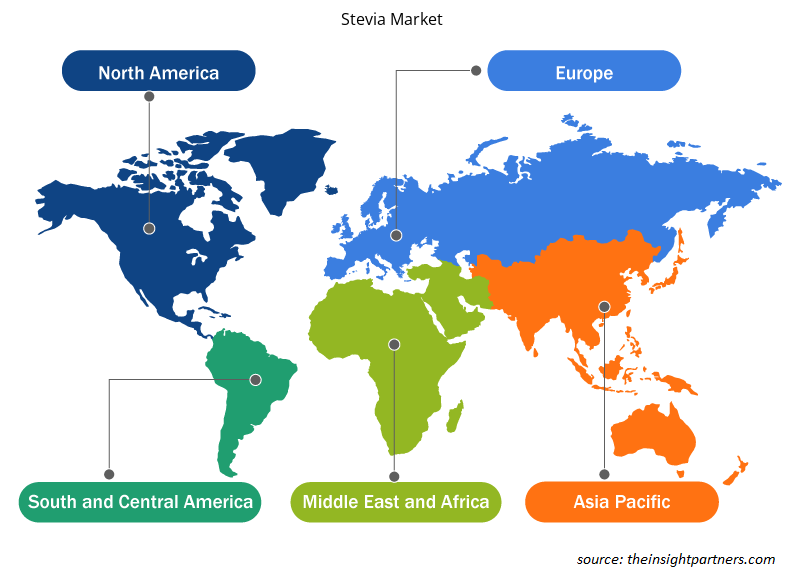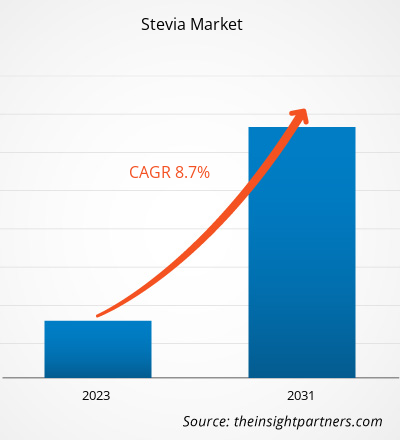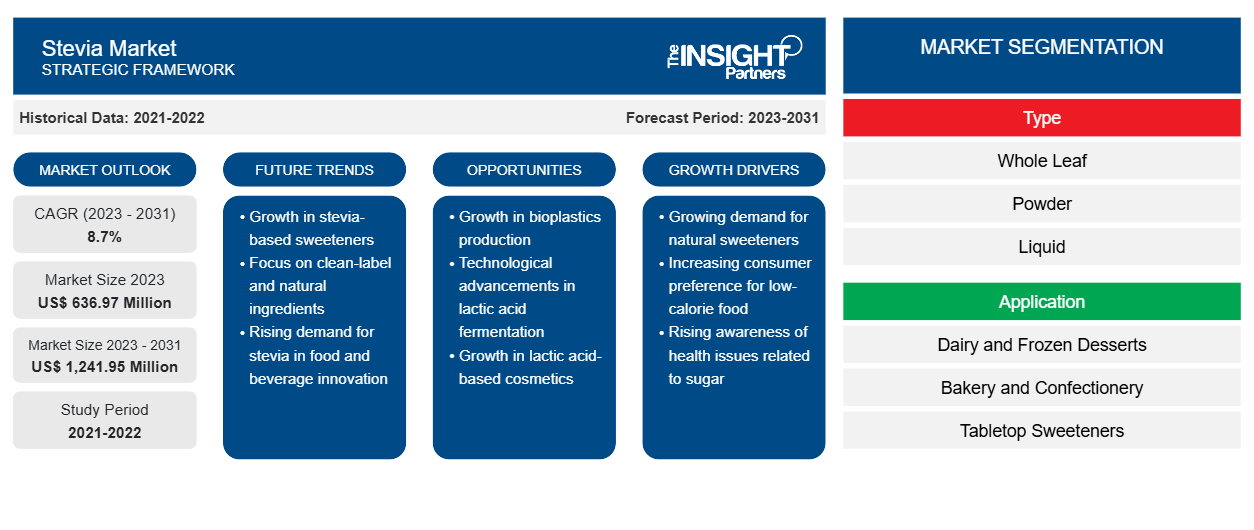Der Stevia-Markt soll von 636,97 Millionen US-Dollar im Jahr 2023 auf 1.241,95 Millionen US-Dollar im Jahr 2031 anwachsen. Der Markt wird zwischen 2023 und 2031 voraussichtlich eine durchschnittliche jährliche Wachstumsrate (CAGR) von 8,7 % verzeichnen. Der steigende Trend zu kalorienarmen Zuckeralternativen mit zunehmendem Kalorienbewusstsein dürfte der wichtigste Trend auf dem Markt bleiben.
Stevia Marktanalyse
Das wachsende Bewusstsein für gesunde Ernährung und das steigende Gesundheitsbewusstsein der Menschen sind die Haupttreiber für den Stevia-Markt weltweit. Länder wie die USA, Deutschland, Großbritannien, Kanada, China, Japan und Südkorea tragen maßgeblich zum weltweiten Marktwachstum bei. Verbraucher suchen nach ähnlichen Etiketten und natürlichen Inhaltsstoffen, da sie sich ihrer eigenen Ernährung immer bewusster werden. Auch das gestiegene Bewusstsein für Fettleibigkeit, Gewichtskontrolle und die Bedeutung einer gesunden Ernährung treibt die Nachfrage nach Stevia-basierten Produkten weltweit in die Höhe. Der globale Markt für Stevia wächst aufgrund von Fortschritten in der Lebensmittel- und Getränkeindustrie. Die Lebensmittel- und Getränkeindustrie ist der größte Produktionsbereich in den Ländern der Welt. Der zunehmende Konsum von verarbeiteten Lebensmitteln bei Verbrauchern aufgrund eines geschäftigen Lebensstils und der Bequemlichkeit treibt das Wachstum des Stevia-Marktes an.
Stevia Marktübersicht
Die zunehmende Vorliebe der Verbraucher für natürliche Süßstoffe treibt das globale Wachstum des Stevia-Marktes voran. Angesichts der weltweit steigenden Zahl von Diabetes- und Fettleibigkeitsfällen greifen Verbraucher zunehmend auf natürliche Süßstoffe zurück. Laut der International Diabetes Foundation werden bis 2040 641 Millionen Menschen an Diabetes erkrankt sein, 2015 waren es noch 415 Millionen. Fettleibigkeit ist eine weit verbreitete Krankheit, die neben anderen chronischen Krankheiten wie Bluthochdruck, metabolischem Syndrom, Herz-Kreislauf-Risiken und Retinopathie zu Diabetes führt. Die Behörden auf der ganzen Welt konzentrieren sich auf einen gesünderen Lebensstil, der eine Reduzierung der aufgenommenen Kalorienzahl, insbesondere des zugesetzten Zuckers, beinhaltet. Die Weltgesundheitsorganisation (WHO) hat eine Verringerung des zugesetzten Zuckers im täglichen Lebensstil empfohlen. Um die Zuckeraufnahme zu senken, bevorzugen Verbraucher natürliche Süßstoffe wie Stevia, die bei der Gewichtskontrolle helfen, indem sie zugesetzten Zucker und Kalorien reduzieren. Darüber hinaus konsumieren Verbraucher in Europa zunehmend Produkte ohne zugesetzten Zucker. Laut der Umfrage „New Nutrition Business“ aus dem Jahr 2020 versuchen zwei Drittel der europäischen Verbraucher, ihren Zuckerkonsum zu senken, da Fettleibigkeit und Diabetes immer häufiger auftreten. Dies hat zu einer erhöhten Nachfrage nach Stevia in Europa geführt. Die zunehmende Vorliebe der Verbraucher für natürliche Süßstoffe treibt also das Wachstum des Stevia-Marktes voran.
Passen Sie diesen Bericht Ihren Anforderungen an
Sie erhalten kostenlos individuelle Anpassungen an jedem Bericht, einschließlich Teilen dieses Berichts oder einer Analyse auf Länderebene, eines Excel-Datenpakets sowie tolle Angebote und Rabatte für Start-ups und Universitäten.
-
Holen Sie sich die wichtigsten Markttrends aus diesem Bericht.Dieses KOSTENLOSE Beispiel umfasst eine Datenanalyse von Markttrends bis hin zu Schätzungen und Prognosen.
Treiber und Chancen auf dem Stevia-Markt
Wachsende Bedenken hinsichtlich Diabetes und Fettleibigkeit begünstigen den Markt
Angesichts der weltweit steigenden Zahl von Diabetes- und Fettleibigkeitserkrankungen greifen Verbraucher zunehmend auf natürliche Süßungsmittel zurück. Laut der International Diabetes Foundation werden bis 2040 641 Millionen Menschen an Diabetes erkrankt sein; 2015 waren es noch 415 Millionen. Fettleibigkeit ist eine weit verbreitete Krankheit, die neben anderen chronischen Krankheiten wie Bluthochdruck, metabolischem Syndrom, Herz-Kreislauf-Risiken und Retinopathie zu Diabetes führt. Behörden auf der ganzen Welt konzentrieren sich auf einen gesünderen Lebensstil, der eine Reduzierung der aufgenommenen Kalorienzahl, insbesondere von zugesetztem Zucker, einschließt. Die Weltgesundheitsorganisation (WHO) hat empfohlen, den zugesetzten Zucker im täglichen Leben zu reduzieren. Um die Zuckeraufnahme zu senken, bevorzugen Verbraucher natürliche Süßstoffe wie Stevia, die bei der Gewichtskontrolle helfen, indem sie zugesetzten Zucker und Kalorien reduzieren. Darüber hinaus konsumieren Verbraucher in Europa zunehmend Produkte ohne zugesetzten Zucker. Laut der Umfrage „New Nutrition Business“ aus dem Jahr 2020 versuchen zwei Drittel der europäischen Verbraucher, ihren Zuckerkonsum zu senken, da die Zahl der Fälle von Fettleibigkeit und Diabetes zunimmt, was zu einer erhöhten Nachfrage nach Stevia in Europa geführt hat. Somit treibt eine zunehmende Vorliebe der Verbraucher für natürliche Süßstoffe das Wachstum des Stevia-Marktes voran.
Steigende Nachfrage nach kalorienarmen Süßstoffen in Lebensmitteln und Getränken
Unternehmen werden sich der Verwendung von Stevia immer bewusster; Pepsi und Coca-Cola beispielsweise haben begonnen, Stevia als Süßungsmittel in ihren Softdrinks zu verwenden. Stevia wird auch von anderen Herstellern von Lebensmitteln und Getränken wie Joghurts, Süßigkeiten und verarbeiteten Lebensmitteln wie Ketchup verwendet. Die Marktchancen werden auch durch Entwicklungen bei der Stevia-Kennzeichnung erhöht. Die neue EU-Kennzeichnungsaktualisierung, die den Produktnamen von „Steviolglycoside (E 960)“ in „Steviolglycoside aus Stevia (E 960)“ ändert, bietet den Verbrauchern zusätzliche Transparenz und Informationen über den botanischen Ursprung des Produkts. Die Verbrauchernachfrage wird voraussichtlich von der Änderung beeinflusst. Laut Cargills Ingredient Tracker kennen nur etwa 25 % der europäischen Verbraucher den Begriff „Steviolglycoside“, während 64 % mit „Stevia“ vertraut sind. Da die Verbraucher jedoch stärker auf die Inhaltsstoffe verarbeiteter Lebensmittel und Getränke achten, wird die Bekanntheit des Begriffs „Steviolglykoside“ voraussichtlich im Laufe der Zeit zunehmen, was in den kommenden Jahren neue Möglichkeiten eröffnen dürfte.
Stevia-Marktbericht – Segmentierungsanalyse
Wichtige Segmente, die zur Ableitung der Stevia-Marktanalyse beigetragen haben, sind Typ und Anwendung
- Der Stevia-Markt ist nach Typ in ganze Blätter, Pulver und Flüssigkeit unterteilt. Das Pulversegment hatte 2023 den größten Marktanteil. Ein weißes Stevia-Pulver ist ein natürlicher und gesunder Ersatz für Zucker. Stevia-Blätter werden getrocknet, um das Pulver zu bilden, und die pulverisierte Form von Stevia ist mit den Extrakten von Stevia-Blättern und Erythrit angereichert.
- In Bezug auf die Anwendung ist der Markt in Milchprodukte und Tiefkühldesserts, Backwaren und Süßwaren, Süßstoffe für den Tisch, Getränke und andere unterteilt. Das Segment Milchprodukte und Tiefkühldesserts hielt im Jahr 2023 einen erheblichen Marktanteil. Die steigende Nachfrage nach kalorienarmen Süßstoffen in Eiscreme, Joghurt, Milchshakes und anderen Milchprodukten aufgrund des zunehmenden Kalorienbewusstseins und der zunehmenden Präferenz für Produkte mit der Auslobung „ohne Zuckerzusatz“ dürfte die Nachfrage nach Stevia in Milchprodukten und Tiefkühldesserts ankurbeln und das Wachstum des Segments vorantreiben.
Stevia-Marktanteilsanalyse nach geografischer Lage
Der geografische Umfang des Stevia-Marktberichts ist hauptsächlich in fünf Regionen unterteilt: Nordamerika, Asien-Pazifik, Europa, Naher Osten und Afrika sowie Süd- und Mittelamerika.
Der asiatisch-pazifische Raum dominiert den Markt. In der Region Asien-Pazifik sind Verbraucher, Gesundheitsexperten und Regierungen zunehmend auf Gesundheit und Ernährung bedacht. Dies hat dazu geführt, dass verschiedene Lebensmittel- und Getränkehersteller auf natürliche Süßstoffe wie Stevia zurückgreifen. Stevia ist ein Süßstoff auf Pflanzenbasis, der sich gut für verschiedene Lebensmittel- und Getränkeanwendungen eignet. Mit der zunehmenden Bedeutung des Süßstoffs Stevia hat seine Verwendung auch in kohlensäurehaltigen Erfrischungsgetränken, Eiscreme, Backwaren, aromatisiertem und kohlensäurehaltigem Mineralwasser, trinkfertigen Tees und Kaffees, aromatisierter Milch, Tischsüßstoffen und anderen Lebensmittel- und Getränkeprodukten in der Region zugenommen. Die verschiedenen Regierungsrichtlinien tragen ebenfalls zum Wachstum des Stevia-Marktes in der Region bei. So hat das Gesundheitsministerium von Singapur (MOH) mehrere Richtlinien empfohlen, die sich auf die Lebensmittel- und Getränkeindustrie auswirken könnten, darunter das Verbot des Verkaufs von stark zuckerhaltigen Fertiggetränken und die Erhebung einer Steuer auf zuckerhaltige Getränke.
Regionale Einblicke zum Stevia-Markt
Die regionalen Trends und Faktoren, die den Stevia-Markt im Prognosezeitraum beeinflussen, wurden von den Analysten von Insight Partners ausführlich erläutert. In diesem Abschnitt werden auch Stevia-Marktsegmente und -Geografie in Nordamerika, Europa, im asiatisch-pazifischen Raum, im Nahen Osten und Afrika sowie in Süd- und Mittelamerika erörtert.

- Holen Sie sich regionale Daten zum Stevia-Markt
Umfang des Stevia-Marktberichts
| Berichtsattribut | Details |
|---|---|
| Marktgröße im Jahr 2023 | 636,97 Millionen US-Dollar |
| Marktgröße bis 2031 | 1.241,95 Millionen US-Dollar |
| Globale CAGR (2023 - 2031) | 8,7 % |
| Historische Daten | 2021-2022 |
| Prognosezeitraum | 2023–2031 |
| Abgedeckte Segmente |
Nach Typ
|
| Abgedeckte Regionen und Länder |
Nordamerika
|
| Marktführer und wichtige Unternehmensprofile |
|
Dichte der Stevia-Marktakteure: Deren Einfluss auf die Geschäftsdynamik verstehen
Der Stevia-Markt wächst rasant, angetrieben durch die steigende Nachfrage der Endverbraucher aufgrund von Faktoren wie sich entwickelnden Verbraucherpräferenzen, technologischen Fortschritten und einem größeren Bewusstsein für die Vorteile des Produkts. Mit der steigenden Nachfrage erweitern Unternehmen ihr Angebot, entwickeln Innovationen, um die Bedürfnisse der Verbraucher zu erfüllen, und nutzen neue Trends, was das Marktwachstum weiter ankurbelt.
Die Marktteilnehmerdichte bezieht sich auf die Verteilung der Firmen oder Unternehmen, die in einem bestimmten Markt oder einer bestimmten Branche tätig sind. Sie gibt an, wie viele Wettbewerber (Marktteilnehmer) in einem bestimmten Marktraum im Verhältnis zu seiner Größe oder seinem gesamten Marktwert präsent sind.
Die wichtigsten auf dem Stevia-Markt tätigen Unternehmen sind:
- Cargill, Incorporated
- Ingredion Incorporated
- Tate & Lyle PLC
- GLG LIFE TECH CORP
- ADM
- Sunwin Stevia International, Inc.
Haftungsausschluss : Die oben aufgeführten Unternehmen sind nicht in einer bestimmten Reihenfolge aufgeführt.

- Überblick über die wichtigsten Akteure auf dem Stevia-Markt
Neuigkeiten und aktuelle Entwicklungen zum Stevia-Markt
Der Stevia-Markt wird durch die Erhebung qualitativer und quantitativer Daten aus Primär- und Sekundärforschung bewertet, die wichtige Unternehmensveröffentlichungen, Verbandsdaten und Datenbanken einbeziehen. Nachfolgend sind einige der Entwicklungen auf dem Stevia-Markt aufgeführt:
- Tate & Lyle PLC (Tate & Lyle), ein weltweit führender Anbieter von Zutatenlösungen für gesündere Lebensmittel und Getränke, freut sich, eine neue Ergänzung seines Süßstoffportfolios bekannt zu geben – TASTEVA® SOL Stevia-Süßstoff. Dieser international patentgeschützte Durchbruch in der Stevia-Technologie erweitert die Fähigkeit von Tate & Lyle, Kunden bei der Lösung von Stevia-Löslichkeitsproblemen in Lebensmitteln und Getränken zu unterstützen und trägt dazu bei, die Nachfrage der Verbraucher nach gesünderen und schmackhafteren Produkten mit reduziertem Zucker- und Kaloriengehalt zu erfüllen. (Quelle: Tate and Lyle, Unternehmenswebsite, Juli 2023)
- Ingredion Incorporated (NYSE: INGR), ein weltweit führender Anbieter von Spezialzutaten für die Lebensmittel- und Getränkeindustrie, gibt die Erweiterung der Stevia-Produktionsanlage von PureCircle™ by Ingredion in Malaysia bekannt und baut damit seine Position als größter Betreiber von Stevia-Zutaten aus Biokonversion weiter aus. Diese Erweiterung erhöht die Kapazität der Biokonversionstechnologie von PureCircle und unterstützt das Vierfache der aktuellen Kapazität für diese Zutaten. Die Investition erhöht den Umfang und die Versorgung mit den wohlschmeckendsten Stevia-Blattzutaten zum Ersatz von Zucker und künstlichen Süßstoffen in allen Lebensmittel- und Getränkekategorien erheblich. (Ingredion, Pressemitteilung, November 2023)
Abdeckung und Ergebnisse des Stevia-Marktberichts
Der Bericht „Stevia-Marktgröße und -Prognose (2021–2031)“ bietet eine detaillierte Analyse des Marktes, die die folgenden Bereiche abdeckt:
- Stevia-Marktgröße und -Prognose auf globaler, regionaler und Länderebene für alle wichtigen Marktsegmente, die im Rahmen des Berichts abgedeckt sind
- Stevia-Markttrends sowie Marktdynamik wie Treiber, Einschränkungen und wichtige Chancen
- Detaillierte PEST/Porters Five Forces- und SWOT-Analyse
- Stevia-Marktanalyse mit wichtigen Markttrends, globalen und regionalen Rahmenbedingungen, wichtigen Akteuren, Vorschriften und aktuellen Marktentwicklungen
- Branchenlandschaft und Wettbewerbsanalyse, einschließlich Marktkonzentration, Heatmap-Analyse, prominenten Akteuren und aktuellen Entwicklungen für den Stevia-Markt
- Detaillierte Firmenprofile
- Historische Analyse (2 Jahre), Basisjahr, Prognose (7 Jahre) mit CAGR
- PEST- und SWOT-Analyse
- Marktgröße Wert/Volumen – Global, Regional, Land
- Branchen- und Wettbewerbslandschaft
- Excel-Datensatz
Aktuelle Berichte
Erfahrungsberichte
Grund zum Kauf
- Fundierte Entscheidungsfindung
- Marktdynamik verstehen
- Wettbewerbsanalyse
- Kundeneinblicke
- Marktprognosen
- Risikominimierung
- Strategische Planung
- Investitionsbegründung
- Identifizierung neuer Märkte
- Verbesserung von Marketingstrategien
- Steigerung der Betriebseffizienz
- Anpassung an regulatorische Trends























 Kostenlose Probe anfordern für - Stevia-Markt
Kostenlose Probe anfordern für - Stevia-Markt